Tomatoes are the crown jewel of many gardens. Whether you’re a backyard grower, a balcony gardener, or managing a community plot, there’s something special about plucking a sun-warmed, vine-ripened tomato and tasting the freshness you nurtured yourself.
But here’s a challenge: tomatoes can be a bit unruly. Left to their own devices, they sprawl across the ground, taking up valuable space, shading each other, and becoming more vulnerable to pests and disease. The solution? Grow your tomatoes vertically.
Vertical growing transforms messy, ground-level plants into organized, upward-reaching producers that are easier to maintain, healthier, and more productive. In this article, we’ll cover why vertical growing works, how to set it up, and practical tips for making it successful.
Why Vertical Tomato Growing Works So Well
Table of Contents
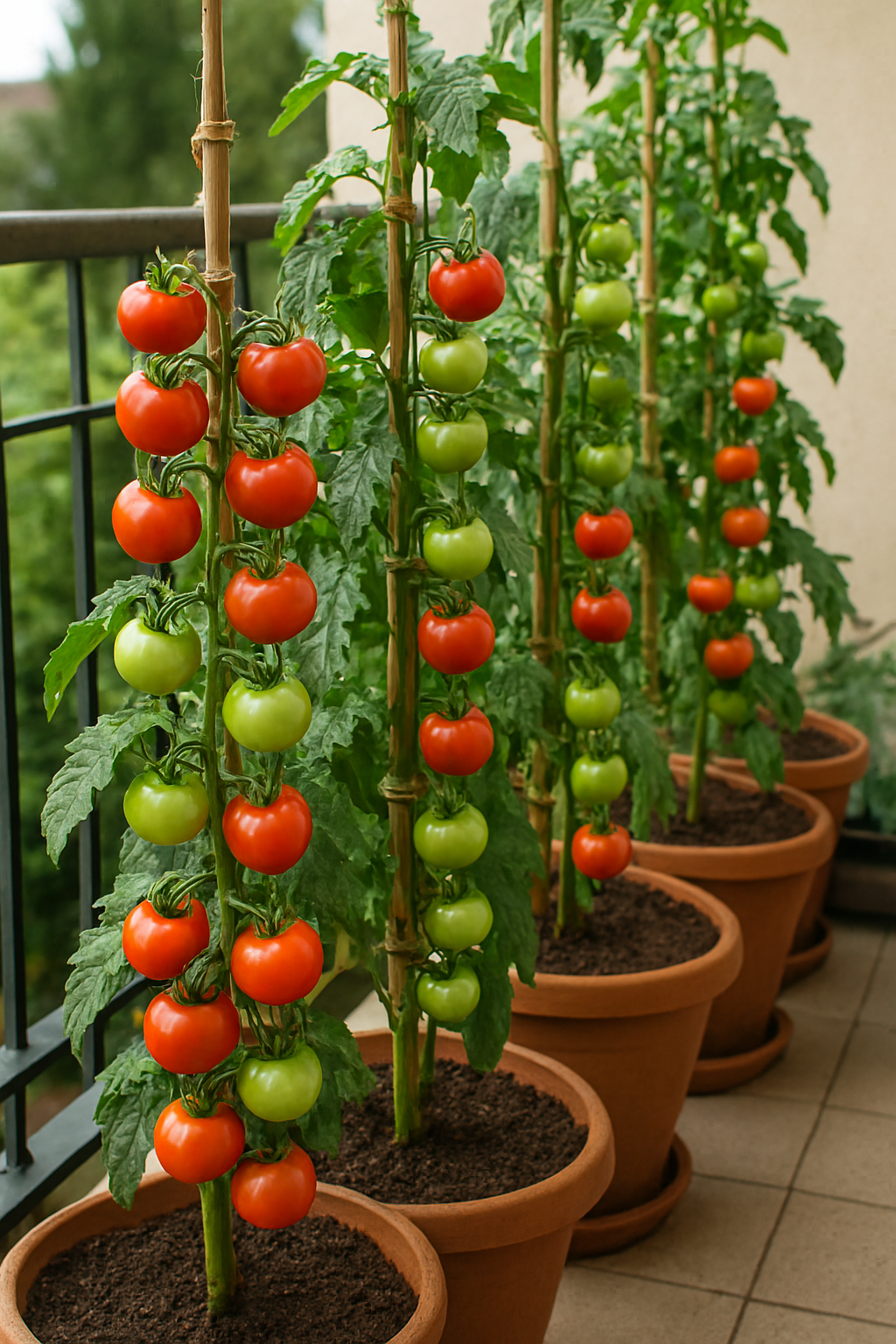
Vertical gardening isn’t just a space-saving hack—it changes the way your tomato plants grow and perform. Let’s look at the main benefits:
Use of Space
If you’re working with a raised bed, a small yard, or containers, vertical growing lets you fit more plants in the same footprint. Instead of sprawling two to three feet in every direction, plants climb up, freeing horizontal space for other crops.
Healthier Plants, Fewer Diseases
When tomato leaves and fruits touch the soil, they’re exposed to soil-borne pathogens like early blight and bacterial wilt. By lifting the plant upward, you create space for air to circulate and keep the foliage drier, which dramatically reduces disease risk.
Simpler Maintenance
Pruning, watering, and harvesting are easier when the plant is right in front of you at eye or chest level. No more crawling through tangled stems to find that one ripe tomato hiding in the back.
Better Sunlight Exposure
Tomato plants grown vertically can be positioned so all sides get sunlight, which improves photosynthesis and results in better fruiting.
Choosing the Right Tomato Varieties for Vertical Growing
While nearly any tomato can be trained upward, your results will vary based on the plant’s natural growth habit.
Indeterminate Tomatoes
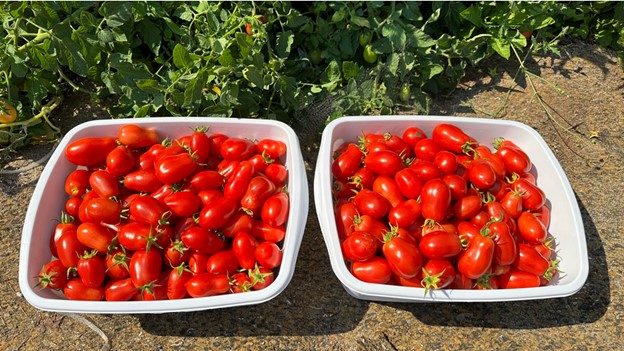
These are vining types that grow and produce fruit continuously until frost. They can reach 8–10 feet or more with support. Perfect for tall stakes, trellises, or string systems. Examples:
- Sungold (cherry, sweet and prolific)
- Cherokee Purple (heirloom slicer)
- Beefsteak (large-fruited)
- Roma (paste tomato, high yield)
Determinate Tomatoes

Also known as bush tomatoes, these grow to a fixed height (usually 3–4 feet) and produce all their fruit in a concentrated period. They’re great for cages and shorter supports but won’t climb as high.
If your goal is continuous harvest over the season and a dramatic vertical display, indeterminate varieties are the way to go.
Popular Vertical Tomato Growing Systems
There’s no one-size-fits-all method—your choice depends on your space, budget, and how much time you want to spend pruning.
Staking – A classic, straightforward method
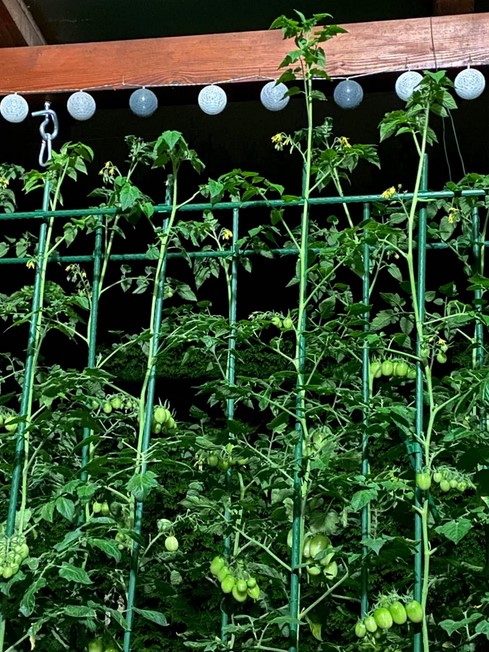
Setup – To stake tomatoes, drive a sturdy wooden or metal stake (6–8 feet tall) into the ground about 6 inches from the plant at the time of planting.
Maintenance – As the plant grows, tie the main stem to the stake with soft plant ties or strips of cloth every 8–10 inches. Prune to a single stem by removing side shoots (suckers).
Pros – Inexpensive, simple, works well in small gardens.
Cons – Requires frequent pruning and tying.
Caging – Cages allow the plant to grow more naturally with multiple stems
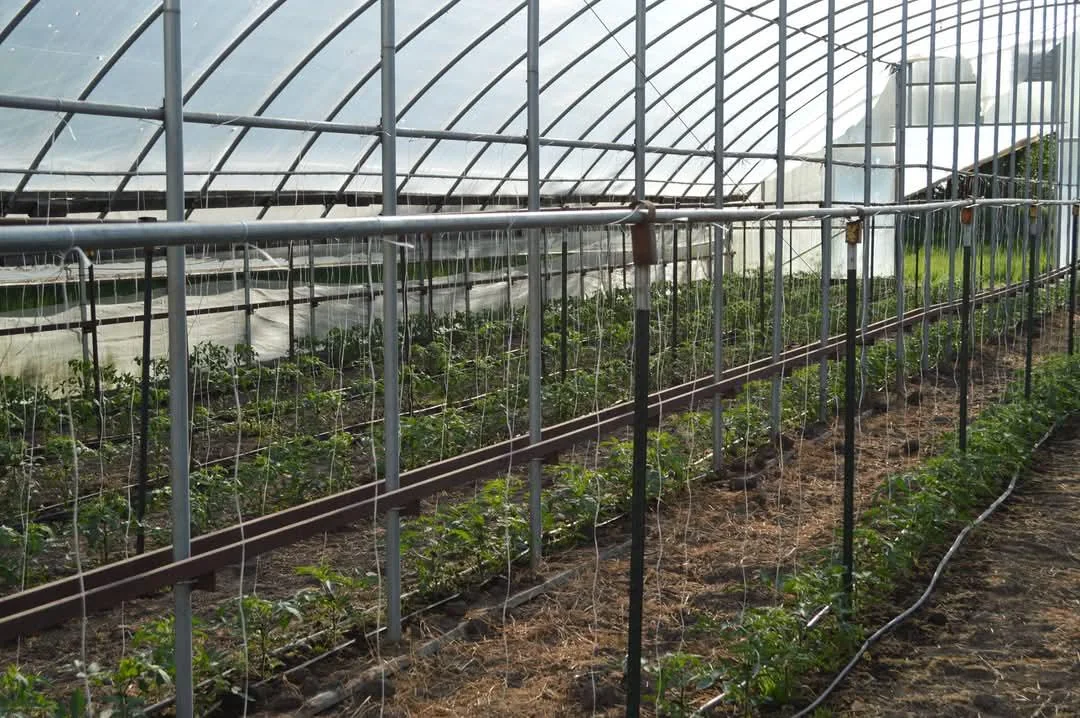
Setup – Place a cylindrical or square wire cage around the plant early in the season.
Maintenance – Minimal pruning—just remove lower leaves for airflow. Cages need to be tall (at least 5 feet) and strong enough to handle heavy fruit.
Pros – Low-maintenance, supports bushier growth.
Cons – Bulky, harder to store, may not be tall enough for vigorous varieties.
Trellising – A good choice for rows of tomatoes or high-yield greenhouse setups
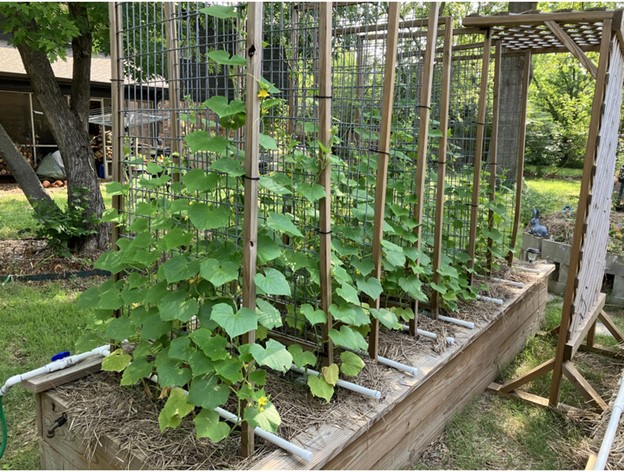
Setup – To trellis tomatoes, build a frame with wooden posts or metal stakes and string, wire, or netting stretched between them.
Maintenance – Plants are trained to climb the structure, either by weaving stems through the netting or tying them at intervals.
Pros – Excellent airflow, visually appealing, supports multiple plants.
Cons – Requires more building effort upfront.
String Method (or Hanging Twine)
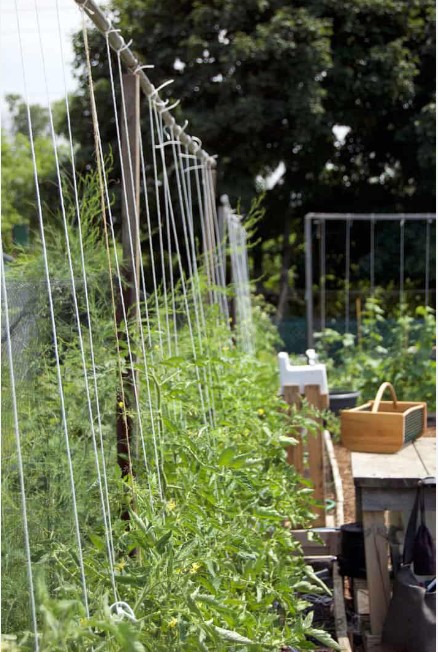
Setup – Attach strings from an overhead bar or ceiling down to each plant’s base. Tie the string loosely around the base and twist the stem around it as it grows.
Maintenance – Regular twisting and pruning to keep one main stem.
Pros – Very space-efficient, great for high tunnels or patios with overhead beams.
Cons – Not ideal in open windy areas; requires an overhead support.
Florida Weave
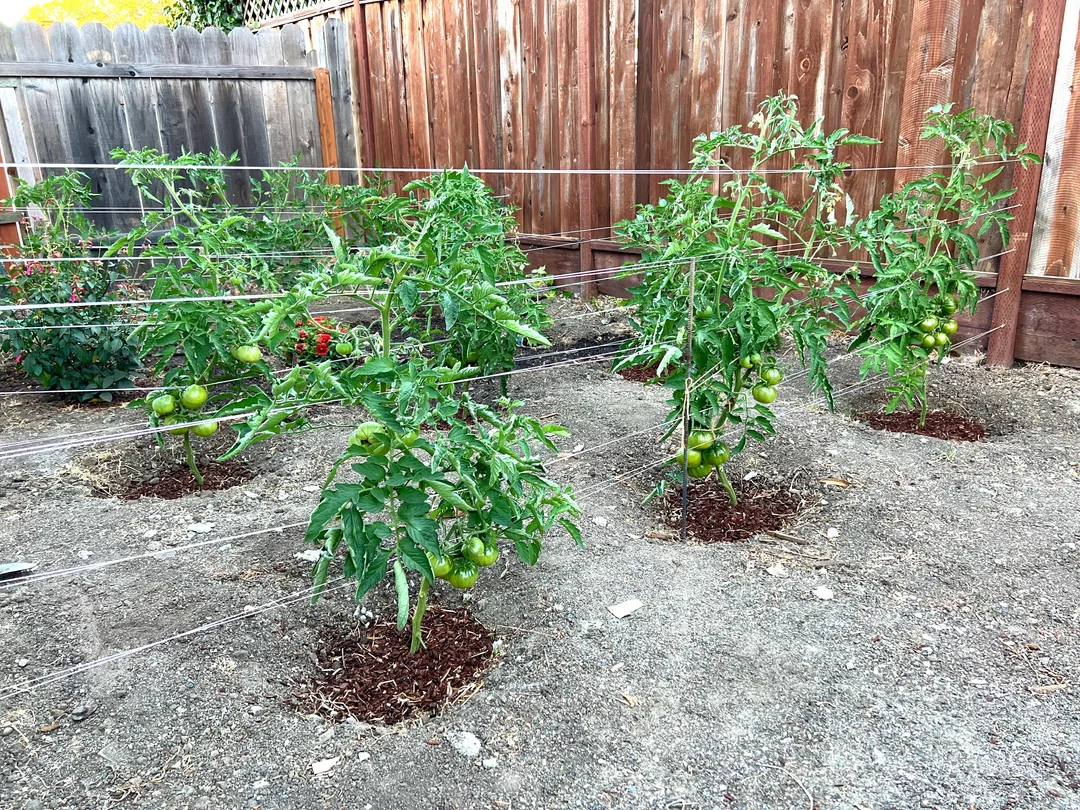
A hybrid between staking and trellising.
Setup – Stakes are placed at the ends and between plants, and twine is woven alternately in front of and behind plants in a zigzag pattern.
Maintenance – Add more twine as plants grow taller.
Pros – Affordable, supports multiple plants in a row.
Cons – Works better for determinate varieties.
Step-by-Step Guide on How to Grow Tomatoes Vertically
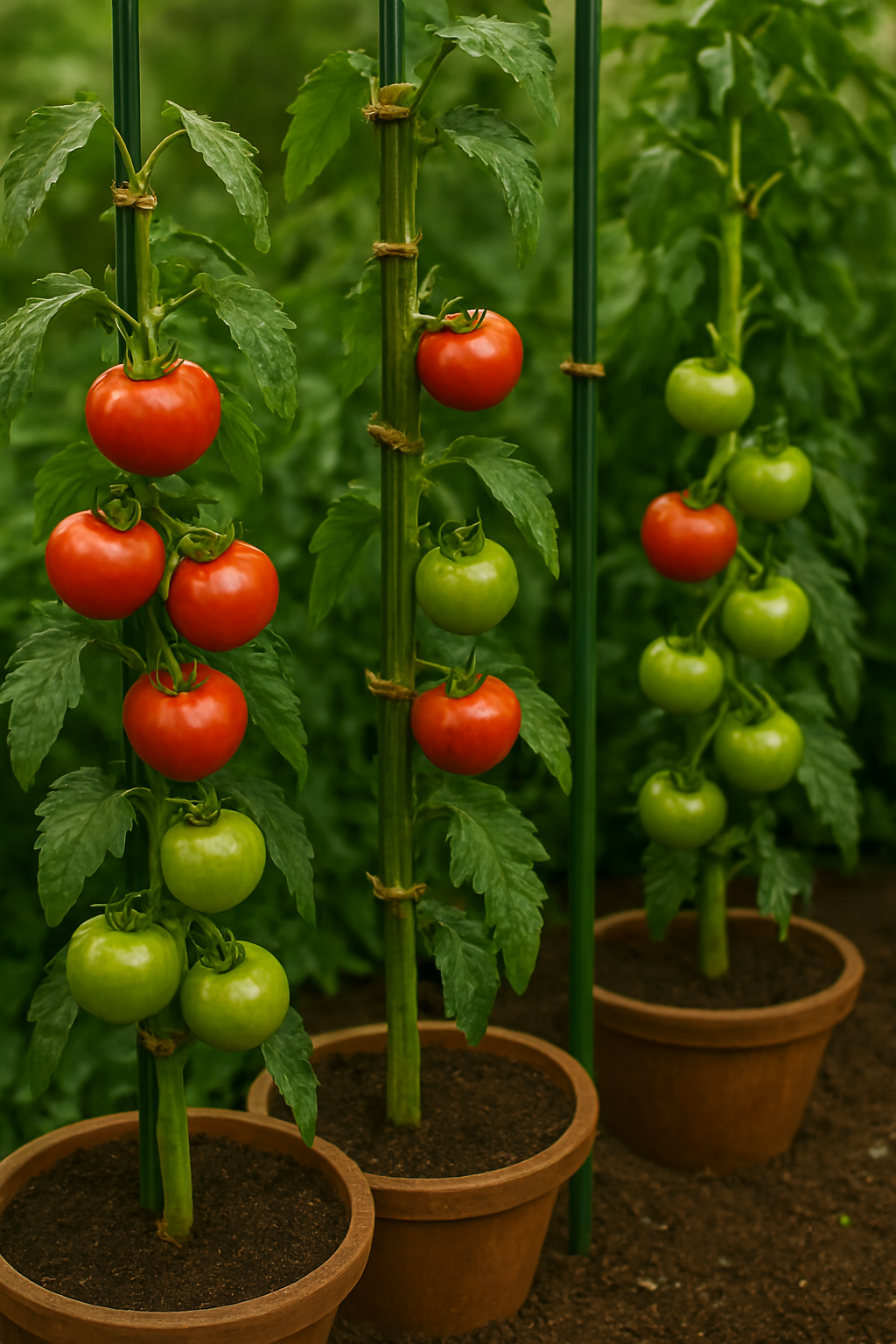
Here’s a process you can follow from planting to harvest:
1. Prepare the Soil
Tomatoes love rich, well-drained soil with a pH of 6.0–6.8. Mix in compost or well-rotted manure before planting. If you’re using containers, choose a high-quality potting mix.
2. Plant Deeply
Tomatoes can form roots along their buried stems. Plant seedlings so that two-thirds of the stem is underground—this creates a stronger root system to support vertical growth.
3. Install Supports Early
Set up stakes, cages, or trellises at planting time. Installing supports later can damage roots and stress plants.
4. Train Your Plants
Guide your tomato stems toward the support system as they grow. Use soft ties to avoid cutting into the stems. For staking or string methods, prune suckers weekly to maintain a single leader.
5. Water Consistently
Irregular watering can cause blossom-end rot or fruit cracking. Deeply water at the soil level rather than overhead to keep leaves dry.
6. Feed Regularly
Once the first fruits form, feed every 2–3 weeks with a balanced tomato fertilizer or liquid seaweed.
7. Monitor for Pests and Diseases
Check regularly for aphids, hornworms, and early blight. Remove diseased leaves promptly. Mulching around the base helps prevent soil from splashing onto leaves.
8. Harvest Often
Picking ripe tomatoes encourages more fruiting. Indeterminate plants will keep producing until frost.
Extra Tips for Vertical Tomato Success
- Mulch Heavily – A 2–3 inch layer of straw, compost, or shredded leaves conserves moisture and suppresses weeds.
- Rotate Crops – Avoid planting tomatoes (or other nightshades like peppers and potatoes) in the same soil each year to prevent disease buildup.
- Use Companion Plants – Basil, marigolds, and onions can deter pests and enhance flavor.
- Support Heavy Clusters – For large-fruited varieties, you may need to sling or net heavy trusses to prevent breaking stems.
- Top Your Plants – If frost is approaching or plants are too tall, pinch off the top growth to redirect energy into ripening existing fruit.
Common Mistakes to Avoid While Growing Tomatoes Vertically
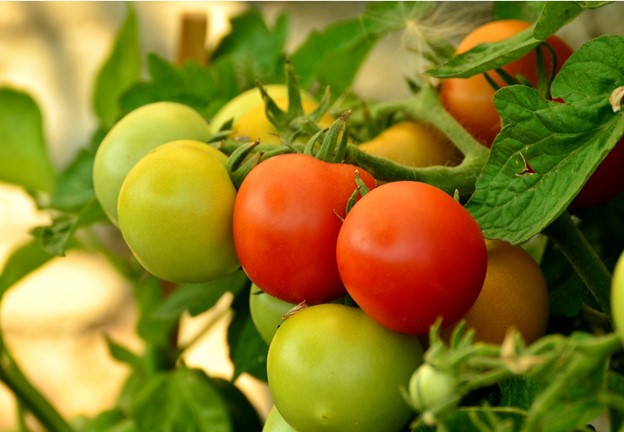
Installing Supports Too Late -Once roots spread, hammering in stakes or pushing in cages can cause serious damage.
- Overcrowding – Even with vertical growth, tomatoes need airflow. Space plants at least 18–24 inches apart.
- Neglecting Pruning – For stake and string methods, skipping pruning can result in tangled, unmanageable vines.
- Tying Too Tightly – Soft ties should be loose enough to allow for stem growth without cutting in.
Final Thoughts
Growing tomatoes vertically combines practical efficiency with the beauty of tall, green vines heavy with fruit. Whether you choose sturdy stakes, roomy cages, elegant trellises, or clever string systems, the key is to give your plants strong support, steady care, and a bit of guidance as they climb.
With the right variety and setup, you’ll enjoy higher yields, healthier plants, and easier harvests—all while making the most of your garden space.
Leave a Reply